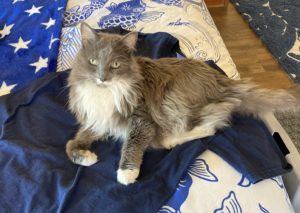
Cats greet other friendly cats by sniffing them first, before engaging in other social activities such as rubbing against each other or grooming each other’s heads. Scent is a way that members of a cat colony identify each other.
We are members of our cats’ social groups and they identify us by our scent. They greet us by sniffing and rubbing against us. When leaving your cat at the vet or boarding facility, you may be asked to bring a blanket or t-shirt with your scent on it. Does your scent comfort your cat when she is away from you?
Recently, researchers at Oregon State University tried to test whether such an object actually reduces a cat’s anxiety when her owner is gone. In this study, owners of 42 cats were asked to bring an unwashed object with their scent on it. Scent objects could include the owner’s shoe, sock, night shirt, or blanket.
The test started by evaluating the cat’s attachment to his/her owner – secure or insecure?
The owner would then leave: in some trials, the scent object was left behind; in others, the cat was alone.
The cat’s behavior was evaluated:
- when he was with his owner
- when he was alone with the scent object
- when he was alone without the scent object
- when his owner returned
Measuring attachment
Psychological attachment is measured using the Secure Base Test. The cat and owner are placed in a strange room for a few minutes; the owner then leaves for a few minutes and returns. The cat’s behavior is observed when the owner is present, when cat is alone, and when the owner returns.
Securely attached cats
willing to explore when Owner is present
continue to explore after Owner leaves
greets Owner on return but continues to explore and play
Insecurely attached cats
reluctant to explore even with Owner present
sit with Owner or hide in corner
do not explore when Owner leaves
may or may not solicit contact with Owner on return
Does your scent comfort your cat when you are not with her?
Researchers took videos of the sessions, recording how often cats vocalized, rubbed on their owners or the scent object, and how long they would stay close to the owner or scent object.
Researcher’s predictions
- Cats would prefer their human caretaker over a scent stimulus alone.
- Insecurely attached cats would interact with the scent object more than the securely attached cats.
- Cats would be comforted by their owner’s scent.
what actually happened
- Cats preferred their owners over the scent object – they vocalized less when owners were with them and rubbed on their owners
- Insecure cats did spend more time close to the scent object than secure cats but only 4 of the 42 cats actually rubbed the object
- The scent object did not seem to alleviate anxiety – cats vocalized just as much when alone with the scent object as they did when alone without the scent object.
Cats communicate in a large part by smell. They identify other cats and their owners by their scent and greet them by sniffing them and rubbing against them. To your cat, your t-shirt smells like you but does your scent comfort your cat the way your physical presence does? The answer is no according to this study.
Your t-shirt is not the same for your cat as a teddy bear that a young child clutches to face the world. The teddy bear is a “transitional object” that helps a human child become less dependent on his parents and learn to relate to other people.
Your cat is attached to you – not your t-shirt. It won’t hurt to leave the t-shirt at home when going to the vet or boarding facility.
Other Thoughts
A cat’s territory where she feels safe is marked with her own scent. Providing your cat with a blanket from home with her scent might make her less anxious.

